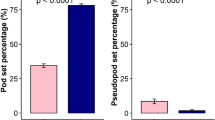Abstract
Twenty-five sweet pepper inbred lines were used to study the heterotic response of economic traits at Hwacheon during 2006/07–2007/08. Out of 25 inbred lines, 12 inbred lines (KNU1006, KNU1015, KNU1017, KNU2006, CO1234, 5AVS1, 5AVS2, 5AVS7, 5SAVS8, SP12, SP27 and SP46) were used as female parents whereas 13 inbred lines (SP9, SP14, SP22, SP25, SP30, SP32, SP34, SP36, SP38, SP43, SP45, SP48 and SP51) were used as male parents and single crosses were made to produce F1 hybrid in 2006/07. Twenty-three F1 hybrids, their parents and three standard varieties (Special, Fiesta and President) were evaluated based on their fruit and fruit quality traits at plastic house in 2007. Variation of fruit yield and fruit characters was observed among the F1 hybrids, their parents and standard varieties. Hybrids of 5AVS7 × SP32, SP12 × SP38, 5AVS7 × SP45, CO1234 × SP32, KNU1015 × SP32, 5AVS7 × SP34, 5AVS8 × SP51 and SP27 × SP25 expressed the highest positive heterosis on fruit number and yield per plant whereas highest positive heterobeltiosis was exhibited by the cross 5AVS7 × SP32 (87.2%) and SP12 × SP38 (119.3%). Hybrid of 5AVS7 × SP32 exhibited the highest heterosis for fruit number (104.0%) and yield (141.2%) per plant. Hybrids of 5AVS7 × SP45, 5AVS7 × SP32, and 5AVS8 × SP48 had highest positive standard heterosis on fruit yield per plant over Special, Fiesta and President. Highest positive standard heterosis had manifested on fruit yield per plant using SP32, SP45, and SP48 inbred lines, which can be used as the male parents with their counterpart female for commercial hybrid production.
Similar content being viewed by others
Literature Cited
Ahmed, N. and H. Muzafar. 2000. Heterosis studies for fruit yield and some economic characters in sweet pepper (Capsicum annuum L.). Capsicum Eggplant Newsl. 19:74–77.
Allard, R.W. 1999. Principles of plant breeding. Wiley, New York p. 254.
Diku, S.P. 1976. Hybrids of sweet pepper bred using male sterility. Byull Vses Nar Rasteinievod. 64:18–19.
Fonesca, S. and F.L. Patternso. 1968. Hybrid vigor in a seven parent diallel crosses in common wheat. Crop Sci. 8:85–88.
Ganeshreddy, M., H.D. Mohankumar, and P.M. Salimath. 2008. Heterosis studies in chillies (Capsicum annuum L.), Karnataka J. Agric. Sci. 21:570–571.
Greenleaf, W.H. 1947. Line breeding as a method of improving the pimento peppers. Proc. Am. Soc. Hortic. Sci. 49:224.
Hill, J., H.C. Becker, and P.M.A. Tigerstedt. 1998. Quantitative and ecological aspects of plant breeding. Chapman and Hall, London p. 275.
Joshi, S. 1986. Results of heterosis breeding on sweet pepper (Capsicum annuum L.) Capsicum Newsl. 6:49–50.
Joshi, S., P.C. Thakur, and T.A. Verma. 1995. Hybrid vigor in bell shaped paprika (Capsicum annuum L.). Vegetable Sci. 22:105–108.
Kallo, G. 1988. Vegetable breeding. Vol. I. CRS Press. Boca Raton p. 122.
Kaul, B.L. and P.P. Sharma. 1988. Heterosis and combining ability studies for some characters in bell pepper (Capsicum annuum L.) Vegetable Sci. 15:171–180.
Lee, Y.M, D.Y. Shim, and B.S. Kuon. 1989. Heterosis of quantitative characters in pepper (Capsicum annuum L.). Kor. J. Breed. Sci. 21:28–34.
Lemma, D. 1998. Seed production guideline for tomatoes, onion and hot pepper. IAR, Addis Ababa p. 22.
Meshram, L.D. and A.M. Mukewar. 1986. Heterosis studies in chilli (Capsicum annuum L.). Scientia Horticulturae 28:219–225.
Meyer, R.C., O. Torjek, M. Becher, and T. Altmann, 2004. Heterosis of biomass production in Arabidopsis. Establishment during early development. Plant Physiol. 134:1813–1823.
Mishra, R.S., R.E. Lotha, S.N. Mishra, P.K. Paul, and H.N. Mishra. 1988. Results of heterosis breeding in chilli (Capsicum annuum L.). Capsicum Newsl. 7:49–50.
Om, Y.H. and H.K. Pyo. 1981. Studies on quantitative characters in red peppers. J. Kor. Soc. Hort. Sci. 22:231–264.
Prasad, N.B.C., K. Madhavi Reddy, and A.T. Sadashiva. 2003. Heterosis studies in chilli (Capsicum annuum L.). Indian J. Hort. 60:69–74.
Rehm, S. and G. Espig. 1984. The cultivated plant of the tropics and subtropics. Eugen Ulmer Gmbh and Co., Stuttgart p. 552.
Seneviratne, K.G..S. and K.N. Kannangara. 2004. Heterosis, heterobeltiosis and commercial heterosis for agronomic traits and yield of chilli (Capsicum annuum L.). Annal of the Sri Lanka Department of Agriculture 6:195–201.
Shrestha, S.L. 2009. Establishment of hybrid breeding system in sweet pepper (Capsicum annuum L.), PhD Thesis, Kangwon National University, Chuncheon, Republic of Korea p. 1–121.
Shull, G.H. 1948. What is heterosis? Genetics 33:439–446.
Singh, A., H.N. Singh, and R.K. Mittal. 1973. Heterosis in chillies. Indian J. Genet. 33:398–406.
Singh, B.D. 1993. Plant breeding principles and methods. Kalyani Publishers, New Delhi p. 896.
Singh, B.D. 1999. Plant breeding principles and methods. Kalyani Publishers, New Delhi p. 185.
Singh, P. 2002. Practices in crop breeding. Kalyani Publishers, New Delhi p. 181.
Singh, Y., T. Singh, and D.S. Khurana. 1992. Heterosis studies in chillies (Capsicum annuum L.). Vegetable Sci. 19:161–165.
Sood, S. and N. Kumar. 2010. Heterosis for fruit yield and related horticultural traits in bell pepper. Vegetable Sci. 16:361–373.
Sprague, G.E. 1983. Heterosis in maize: theory and practice. In: Frankel R. (ed) Heterosis: reappraisal of theory and practice. Springer, Berlin p. 47–70.
Studentsova, L.I. 1973. Choice of pairs of red pepper in breeding for heterosis. Nauchn Tr Maikop Apyt St VNII Rastenievod 7:96–98.
Turner, J.H. 1953. A study of heterosis in upland cotton, combining ability and inbreeding effects. Agronomy J. 45:487–490.
Author information
Authors and Affiliations
Corresponding author
Rights and permissions
About this article
Cite this article
Shrestha, S.L., Luitel, B.P. & Kang, W.H. Heterosis and heterobeltiosis studies in sweet pepper (Capsicum annuum L.). Hortic. Environ. Biotechnol. 52, 278–283 (2011). https://doi.org/10.1007/s13580-011-0106-8
Received:
Accepted:
Published:
Issue Date:
DOI: https://doi.org/10.1007/s13580-011-0106-8




